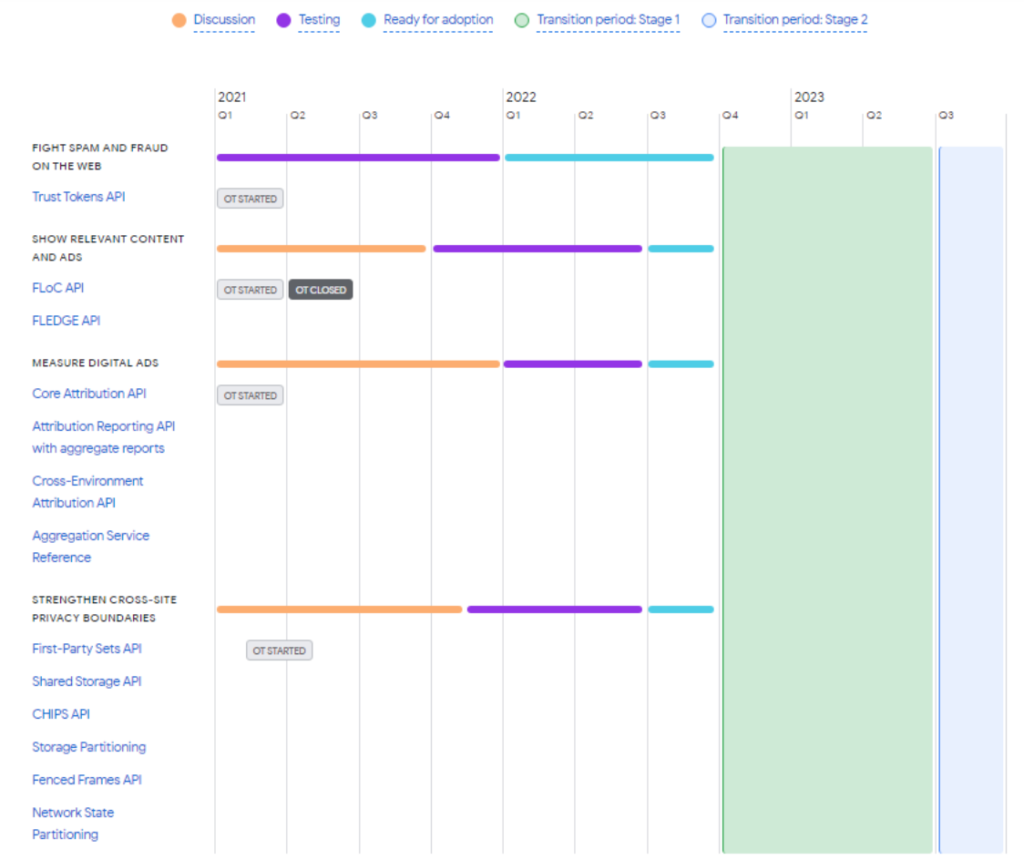Here is the new timeline for Google Privacy Sandbox
It is one of the most anticipated initiatives in international marketing, both for the weight of the proposer and for the revolutionary scope, and after the announcement of the extension arrived in recent weeks it is time to clarify the timing: so here is the new timeline from Google Privacy Sandbox, the official timeline that informs about the stages of development of the various categories of initiatives that fall into the wide Big G project.
Google Privacy Sandbox: what it is and what goals it has
The Sandbox Privacy is the initiative promoted by Google to create web standards that allow sites to access user information without compromising their privacy. Its main purpose is to ease online advertising without the use of third-party cookies, and in fact – among the various technologies proposed – also includes Federated Learning of Cohorts, better known as FloC, which is just the alternative to cookies identified by Mountain View.
As we read on the official website, Privacy Sandbox aims to “build a more private and open Web“, creating web technologies “to protect the privacy of online people and offer companies and developers the tools to build thriving digital activities to keep the web open and accessible to all”.
One of the cornerstones of this initiative is precisely the FloC technology, which should be the meeting point between privacy and adv: it is in fact a new mechanism for targeted advertising, which is based on tracking by cohorts rather than individuals and which places the Web browser in control of the user’s privacy, moving part of the collection and processing of data that facilitate advertising on the user’s device.
The initiative has been defined anti-competitive and has generated various negative responses, both from the institutional point of view (such as the Antitrust investigation in the UK) and from other companies in the sector, and this has pushed Google to slow down on the concrete application: the farewell to third-party cookies and the launch of FloC were initially announced for February 2022, while now the new time horizon is “a period between the middle and the end of 2023”.
New timings for Privacy Sandbox
This remodeling of times also affects the more general Sandbox Privacy, and therefore it becomes useful to be able to count on a synthetic and summary graph.
Updated back in August 2021, the timeline (which we can see below) brings together the Sandbox Privacy proposals (which are at different levels of development) and reflects Google’s predictive timing on when new technologies will be ready to support key use cases, so that Chrome can gradually and responsibly delete third-party cookies.
How to read the timeline
The graph divides the initiatives into four categories:
- Fight against spam and fraud on the Web
which includes the Trust Tokens API technology.
- Presentation of relevant content and ads
which includes the FloC and FLEDGE API technologies (with which Google aims to offer sites a way to retargeting users without intermediaries)
- Measurement of digital ads
which includes Core Attribution API technologies (which serve for attributing views and click ads without the need for cross-site ID), Attribution Reporting API with aggregate reports, Cross-Environment Attribution API and Aggregation Service Reference, that serve at various levels to strengthen cross-site privacy.
- Strengthening of privacy borders between sites
which includes First-Party Sets API, Shared Storage API, CHIPS API, Storage Partitioning, Fenced Frames API and Network State Partitioning technologies.
The steps indicated in the history are the following:
- Discussion. Technologies and their prototypes are discussed in forums such as Github or W3C groups.
- Testing. All technologies for the use case are available for testing developers and can be refined based on the results.
- Ready for adoption. Once completed the development process, successful technologies are ready to be used on a large scale: they will be launched on Chrome and ready for large-scale use on the Web.
- Transition Period: Step 1. APIs for each use case are available for adoption; Chrome will closely monitor adoption and feedback before moving on to the next step.
- Transition period: Step 2. Chrome will phase out support for third-party cookies for a three-month period, which will end at the end of 2023.
A useful update to prepare in time
The Google timeline can be a valuable support for search marketers, who have a time reference to find out when the various initiatives of Privacy Sandbox should be ready for adoption and, above all, provide information on the revolution that affects third-party cookies (and on compliance with the “promises” and predictions about the cookie apocalypse).
At the moment, the transition period: step 1 (where APIs for each use case are available for adoption) is scheduled for the beginning of the fourth quarter of 2022: is that the horizon after which we may have a clearer picture of what it will be like to advertise with Google when third-party cookies will gradually be deprecated.


